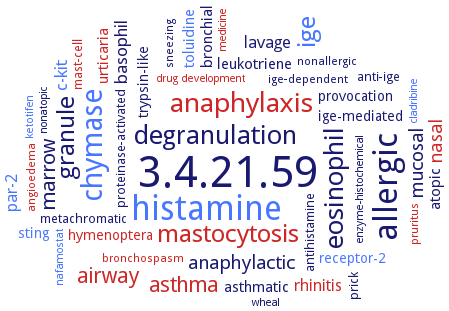3.4.21.59: Tryptase
This is an abbreviated version!
For detailed information about Tryptase, go to the full flat file.

Word Map on EC 3.4.21.59 
-
3.4.21.59
-
histamine
-
allergic
-
chymase
-
anaphylaxis
-
degranulation
-
eosinophil
-
mastocytosis
-
ige
-
granule
-
airway
-
asthma
-
marrow
-
mucosal
-
anaphylactic
-
nasal
-
c-kit
-
basophil
-
lavage
-
par-2
-
rhinitis
-
bronchial
-
asthmatic
-
urticaria
-
atopic
-
leukotriene
-
toluidine
-
sting
-
hymenoptera
-
trypsin-like
-
receptor-2
-
provocation
-
ige-mediated
-
prick
-
anti-ige
-
metachromatic
-
proteinase-activated
-
mast-cell
-
antihistamine
-
sneezing
-
nonallergic
-
ige-dependent
-
angioedema
-
bronchospasm
-
pruritus
-
drug development
-
wheal
-
nonatopic
-
ketotifen
-
nafamostat
-
cladribine
-
enzyme-histochemical
-
medicine
- 3.4.21.59
- histamine
-
allergic
- chymase
- anaphylaxis
-
degranulation
-
eosinophil
- mastocytosis
- ige
- granule
- airway
- asthma
- marrow
- mucosal
-
anaphylactic
- nasal
- c-kit
-
basophil
- lavage
- par-2
- rhinitis
- bronchial
-
asthmatic
- urticaria
-
atopic
-
leukotriene
- toluidine
- sting
- hymenoptera
-
trypsin-like
- receptor-2
-
provocation
-
ige-mediated
-
prick
-
anti-ige
-
metachromatic
-
proteinase-activated
- mast-cell
-
antihistamine
-
sneezing
-
nonallergic
-
ige-dependent
- angioedema
- bronchospasm
- pruritus
- drug development
-
wheal
-
nonatopic
- ketotifen
- nafamostat
- cladribine
-
enzyme-histochemical
- medicine
Reaction
Preferential cleavage: Arg-/-, Lys-/-, but with additional information restricted specificity than trypsin =
Synonyms
alpha 1-tryptase, alpha tryptase, alpha-tryptase, basal serum tryptase, beta tryptase I, beta tryptase II, beta-tryptase, betaI-tryptase, betaII-tryptase, BLCT, bovine liver capsule tryptase, bovine mast cell tryptase, BTM, delta-tryptase, gamma-tryptase, group 2 tryptase, HAST, HMC-1 tryptase, HTbeta, human beta-tryptase, human betaII-tryptase, human lung tryptase, human mast cell tryptase, human mast cell tryptase beta I, human tryptase alpha, human tryptase beta, human tryptase beta/2, human tryptase-beta, Lung tryptase, Mast cell neutral proteinase, mast cell protease 11, mast cell protease 6, mast cell protease 7, Mast cell protease II, mast cell protease-6, Mast cell proteinase II, mast cell specific tryptase, Mast cell tryptase, mast cell tryptase beta, mast cell-derived tryptase, mast cell-specific protease, mast cell-specific tryptase, MC protease 6, MC protease 7, MC protease-6, MC tryptase, MCP-11, MCP-6, MCP-7, Mcpt6, MCT, mMCP-6, mouse mast cell protease 6, mouse mast cell protease-6, Pituitary tryptase, Proteinase, mast cell neutral, Proteinase, mast cell serine, II, Proteinase, mast cell serine, tryptase, Prss31, Rat mast cell protease II, rHT, S-tryptase, sBT, serine protease tryptase, serum baseline tryptase, serum mast cell tryptase, serum tryptase, Skin tryptase, TMT, TPSAB1, TPSB2, transmembrane tryptase, tryptase, tryptase alpha, tryptase alpha-1, tryptase beta, tryptase beta-1, tryptase beta-2, Tryptase M, Tryptase, skin, tryptase-2, tryptase-beta, tryptase-beta1


 results (
results ( results (
results ( top
top





